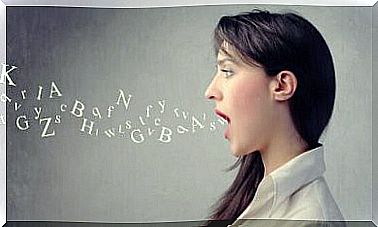Mindfulness-based Therapy Or MBCT

Sometimes the thoughts we generate play against us instead of in our favor. The way we construct our ideas is the source of the problem, and not so much their content or references: the cognitive errors and dysfunctional patterns that lurk in our psyche and make our daily life difficult. The mathematics teacher metaphor used in mindfulness-based therapy (MBCT) is the perfect illustration of arbitrary inference.
One of the dysfunctional cognitive schemes we often face is that of arbitrary inference (or deduction). It is the process of reaching a conclusion without supporting evidence or even with evidence to the contrary. The therapy based on mindfulness explains this mechanism through the metaphor that we illustrate in today’s article.
Arbitrary inference, although a useful strategy based on experience, can lead us to draw wrong conclusions. Let’s see why.
The usefulness of drawing conclusions
It is clear that drawing conclusions from a specific feature or fact can save us time and effort. If we tell Alessandra that Giovanni takes care of the housework, she can deduce that he likes to cook. The next time they meet, she could offer them an evening where everyone brings their favorite dish.
Still, it is possible that Giovanni does not know how to cook even an egg. Even if it is a mistake that we can define as “logical”, it is clear that the tendency to define “normal” things and the experience we think we have in the different scenarios can cause our way of thinking not to be the most appropriate to the situation .

MBCT or mindfulness-based cognitive therapy
The MBCT proposes the integration of two models: cognitive therapy and the Kabatz-Zinn Mindfulness-based Stress Reduction (MBSR ) program. The initial goal of this current merger was to prevent multiple relapses that occur after cessation of therapy for depression. A large number of studies have addressed the residual symptoms and relapses of patients with depression after completing therapy.
The numbers are alarming: around 70% of patients present with cognitive depressive symptoms after therapy. 75% of people who respond positively to treatment have 5 or more residual symptoms. These symptoms are, for the most part, related to problems with concentration, poor attention, difficulty finding words, mental slowdown, and difficulty making decisions.
For this reason, MBCT, developed by Segal, Williams and Teasdale in 2002, is a key therapy in the current clinic. This program is designed from group sessions, in which one works on meditation, feelings and emotions to avoid relapse.
Mindfulness-based therapy trains the patient to direct attention to thought or cognitive forms that break the depressive web, which can reactivate a depressive episode.
Use of metaphors in mindfulness-based therapy
In MBCT it is very common to use metaphors to accompany cognitive change and, above all, to teach the person how to identify an irrational form of thought and act accordingly.
One of the exercises provided by this cognitive therapy is represented by the metaphor of the mathematics teacher. In this exercise, the person is asked to close their eyes and begin to become aware of the thoughts, sensations and emotions generated by the story. These are the only indications given to the patient.
Awareness: the metaphor of the mathematics teacher
The story being told is as follows:
After telling the story, taking the right breaks to allow the person to think, it is helpful to share what happened during the exercise. The normal thing is for the patient to talk about the mistake made after drawing a hasty conclusion.
It is likely that at first the patient thought that Clara, the protagonist of the story, was a pupil, then a teacher, only to discover in the end that she was a janitor.
The danger of drawing the wrong conclusions
This exercise perfectly illustrates how people draw and revise their conclusions as they receive new information. In the case of the story in question, the initial information has been refuted by other data, but this is not always the case.
Nothing and no one must resolve or correct the wrong conclusions we arrive at and, for this reason, it is our responsibility to revise our way of thinking, rather than waiting to be corrected from the outside.
While thinking that Clara is a teacher rather than a janitor is not a particularly serious mistake, this story can be applied to many other situations in life. For example, if Clara is actually Maria, our best friend, whom we see from afar walking and does not greet us, we can formulate different conclusions.
We can think that: Maria is rude, Maria is distracted, Maria is angry or Maria no longer loves me. These arbitrary deductions can have a profound impact on our state of mind, because Mary does not actually identify with any of the labels we have imposed on her. Maria is simply short-sighted and has not seen us.
Likewise, Francesco warns the same day that in the end he will not be able to participate in Claudio’s gift, which has already been bought. The rest of the group of friends may think that Francesco is rude, selfish and that Claudio doesn’t like him.
However, even if these are the conclusions that friends draw without having any other information, they can be completely wrong. Francesco may have financial problems, he may have had a bad argument with Claudio or have other problems with him that others do not know.

Impact of arbitrary deductions: is it our responsibility?
This way of thinking is not only dangerous because it can have a major influence on our mood. Since our thoughts often shape our conduct, the deductions we make can determine the way we behave.
This behavior is motivated by the conclusions we have drawn that, if they are wrong, they can turn into inappropriate behavior. If we stop talking to Maria because she ignored us or if the group of friends discuss and distance themselves from Francis because he is “selfish”, when he is not, we are doing something that, in reality, we do not want, based on reasons that they do not support themselves on the capricious threads that has woven our mind.
Internalizing the mathematics teacher metaphor and remembering it every time we come to a conclusion can be very helpful. Not only will it improve the logic of our rational thinking, but it will also reduce the possibility of adopting wrong positions.









